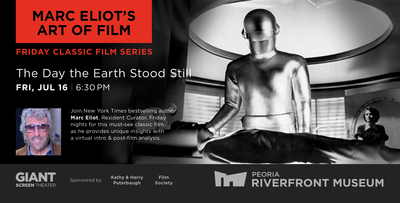

Fri, July 16 | 6:30 PM
Tickets | CLICK HERE
Join us for our weekly film series in the Giant Screen Theater, "Marc Eliot’s Art of Film," with The New York Times Best-Selling Author! Peoria Riverfront Museum is pleased to announce the residency of film critic and historian Marc Eliot, who is the author of more than two dozen books on pop culture and biographies on Hollywood icons. Marc has personally selected each of the films in the "Art of Film" series and provides virtual commentary for each film before and after the film's screening at the museum.
The Day the Earth Stood Still, 1951. USA. Directed by Robert Wise.
Unlike Invasion of the Body Snatchers and The Incredible Shrinking Man, The Day the Earth Stood Still was given a hefty $1 million budget and positioned as a major event cinematic. Robert Wise was already an established A-list director, who’s career began in the early ‘30s. In 1940 and ’41, he worked with Orson Welles on the difficult, detailed and highly effecting editing of Citizen Kane and its follow-up, The Magnificent Ambersons. Wise won a Best Director Oscar for 1959’s West Side Story, another for 1965’s The Sound of Music, and the following year his The San Pebbles, starring Steve McQueen, was nominated for Best Picture of the year (an award category that goes to the producer, not the director). He lost to Fred Zinnemann’s A Man For All Seasons, but was awarded the prestigious Irving Thalberg Memorial Award.
Out of the nearly 70 films Wise directed, The Day the Earth Stood Still comes in the middle of his career. 1951 was the same year HUAC and Hollywood were in full blacklist mode and the “Ban the Bomb” protests reached their peak. A mere 6 years after the end of World War 2 and the nuclear bombing of Japan, the Soviet Union had obtained their own Atomic Bomb, China had a revolution that resulted in the Communist takeover, the Rosenbergs were executed, and the world seemed on the brink of another World War that, this time, was sure to end with nuclear annihilation.
Based on a 1950 short story written by Edward H. North in 1940, a simple invasion-from-outer-space tale, Julian Blaustein, then a major producer at Fox, bought it directly to Daryl F. Zanuck, one of the founding heads of Fox, and convinced him to make the film. Blaustein wanted to update the original story to bring it into the nuclear age, or as some people called it back then, the age of nuclear angst. Blaustein assigned Wise to direct and assured him an A-list cast. It stars the always wonderful, effervescent Patricia Neal in the female lead, Michael Rennie as Klaatu, her Christ-like mentor, his faithful robot “Gort,” played by 7’7” Lock Martin, an usher at the time for Grauman’s Chinese Theater chosen for his size, and the venerable Sam Jaffe as the “Einstein”-type moral high-road scientist. For my generation, the words “Klaatu, verada, niktu” became part of our everyday one-to-one vocabulary, and you’ll discover why when you see the film. This is one of those pictures that carries a message as timely in 1951 as it is today – the world must live in peace.
Shot on the back lot of the Fox studios (now a series of hi-rises known as “Century City”), with exteriors filmed at Fort George G. Meade in Maryland, The Day the Earth Stood Still was an instant hit with audiences. It made a star out of the British-born Rennie, reinvigorated Neal’s illustrious, if fading career and influenced a future generation of filmmakers, most notably George Lucas and Stanley Kubrick. In 1995, it was selected for preservation in the United States National Film Registry as "culturally, historically, or aesthetically significant."
- Marc Eliot